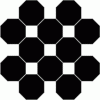Gooblah
Heh...
- Joined
- Jun 5, 2007
- Messages
- 4,282
Squares. However nice and fancy Hexes are, they would be extremely unintuitive and hard to code relative to squares. Yes, there's the 'diagonal movement problem', but honestly, how many players would realistically build 'Maginot Lines' and other such Fortifications? I know I don't. You can make such Fortifications now by stringing Forts and tacking on the occasional
XX
X
pattern to deal with diagonal entry.
XX
X
pattern to deal with diagonal entry.


